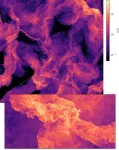(Press-News.org) BOSTON - A diet rich in healthy and plant-based foods is linked with the presence and abundance of certain gut microbes that are also associated with a lower risk of developing conditions such as obesity, type 2 diabetes and cardiovascular disease, according to recent results from a large-scale international study that was co-senior authored by Andrew T. Chan, MD, MPH, from Massachusetts General Hospital (MGH). The report appears in Nature Medicine.
"This study demonstrates a clear association between specific microbial species in the gut, certain foods, and risk of some common diseases," says Chan, a gastroenterologist, chief of the Clinical and Translational Epidemiology Unit at MGH, and professor of medicine at Harvard Medical School. "We hope to be able to use this information to help people avoid serious health problems by changing their diet to personalize their gut microbiome."
The PREDICT 1 (Personalized Responses to Dietary Composition Trial 1) metagenomic study analyzed detailed data on the composition of participants' microbiomes, their dietary habits, and cardiometabolic blood biomarkers. The researchers found strong evidence that the microbiome is linked with specific foods and diets, and that, in turn, its composition is also associated with levels of metabolic biomarkers of disease. Further, the microbiome has a greater association with these markers than other factors, such as genetics.
"Studying the interrelationship between the microbiome, diet and disease involves a lot of variables because peoples' diets tend to be personalized and may change quite a bit over time," explains Chan. "Two of the strengths of this trial are the number of participants and the detailed information we collected."
PREDICT 1 is an international collaboration to study links between diet, the microbiome, and biomarkers of cardiometabolic health. The researchers gathered microbiome sequence data, detailed long-term dietary information, and results of hundreds of cardiometabolic blood markers from just over 1,100 participants in the U.K. and the U.S.
The researchers found that participants who ate a diet rich in healthy, plant-based foods were more likely to have high levels of specific gut microbes. The makeup of participants' gut microbiomes was strongly associated with specific nutrients, foods, food groups and general dietary indices (overall diet composition). The researchers also found robust microbiome-based biomarkers of obesity as well as markers for cardiovascular disease and impaired glucose tolerance.
Epidemiologist Tim Spector of King's College London, who started the PREDICT study, says: "When you eat, you're not just nourishing your body, you're feeding the trillions of microbes that live inside your gut."
For example, having a microbiome rich in Prevotella copri and Blastocystis species was associated with maintaining a favorable blood sugar level after a meal. Other species were linked to lower post-meal levels of blood fats and markers of inflammation. The trends they found were so consistent, the researchers believe that their microbiome data can be used to determine the risk of cardiometabolic disease among people who do not yet have symptoms, and possibly to prescribe a personalized diet designed specifically to improve someone's health.
"We were surprised to see such large, clear groups of 'good' and 'bad' microbes emerging from our analysis," says Nicola Segata, PhD, professor and principal investigator of the Computational Metagenomics Lab at the University of Trento, Italy and coordinator of the analysis of the microbiome data in the study. "And it is intriguing to see that microbiologists know so little about many of these microbes that they are not even named yet."
Curtis Huttenhower, PhD, a co-senior author who co-directs the Harvard T.H. Chan Microbiome in Public Health Center, adds: "Both diet and the gut microbiome are highly personalized. PREDICT is one of the first studies to begin unraveling this complex molecular web at scale."
Francesco Asnicar, PhD, and Sarah Berry, PhD, are co-first authors of the study. Other collaborators were from health science company ZOE, which supported the research.
About the Massachusetts General Hospital
Massachusetts General Hospital, founded in 1811, is the original and largest teaching hospital of Harvard Medical School. The Mass General Research Institute conducts the largest hospital-based research program in the nation, with annual research operations of more than $1 billion and comprises more than 9,500 researchers working across more than 30 institutes, centers and departments. In August 2020, Mass General was named #6 in the U.S. News & World Report list of "America's Best Hospitals."
INFORMATION:
Smartwatches and other battery-powered electronics would be even smarter if they could run AI algorithms. But efforts to build AI-capable chips for mobile devices have so far hit a wall - the so-called "memory wall" that separates data processing and memory chips that must work together to meet the massive and continually growing computational demands imposed by AI.
"Transactions between processors and memory can consume 95 percent of the energy needed to do machine learning and AI, and that severely limits battery life," said computer scientist Subhasish Mitra, senior author of a new study published in Nature Electronics.
Now, a team that includes Stanford computer scientist ...
Fish populations tend to do better in places where rigorous fisheries management practices are used, and the more measures employed, the better for fish populations and food production, according to a new paper published Jan. 11 in Nature Sustainability.
The study, led by Michael Melnychuk of the University of Washington's School of Aquatic and Fishery Sciences, draws upon the expertise of more than two dozen researchers from 17 regions around the world. The research team analyzed the management practices of nearly 300 fish populations to tease out patterns that lead to healthier fisheries across different locations. Their findings confirmed, through extensive data analysis, what many researchers ...
Galaxies begin to "die" when they stop forming stars, but until now astronomers had never clearly glimpsed the start of this process in a far-away galaxy. Using the Atacama Large Millimeter/submillimeter Array (ALMA), in which the European Southern Observatory (ESO) is a partner, astronomers have seen a galaxy ejecting nearly half of its star-forming gas. This ejection is happening at a startling rate, equivalent to 10 000 Suns-worth of gas a year -- the galaxy is rapidly losing its fuel to make new stars. The team believes that this spectacular event was triggered by a collision with another ...
Most organisms on earth depend on the energy from the sun. Sunlight is also an important coordinator of life's timers. Animals take important cues for proliferation, activity, feeding, or sleep from changing light conditions. These rhythms also exist in humans - as changing light conditions across the year can strongly impact human mood and psychology.
Part of the natural light from the sun we are exposed to consists of ultraviolet (UVA and UVB) light, a short-wavelength part of the spectrum that is largely missing in artificial lighting. So far, most research on seasonal cycles has focused on daylength. "In contrast to previous assumptions, we discovered that, in addition to daylength, the intensity of UVA light influences the seasonal responses of the bristle worm ...
Astronomers have looked nine billion years into the past to find evidence that galaxy mergers in the early universe could shut down star formation and affect galaxy growth.
New research led by Durham University, UK, the French Alternative Energies and Atomic Energy Commission (CEA)-Saclay and the University of Paris-Saclay, shows that a huge amount of star-forming gas was ejected into the intergalactic medium by the coming together of two galaxies.
The researchers say that this event, together with a large amount of star formation in the nuclear regions ...
Through the centuries, scientists and non-scientists alike have looked at the night sky and felt excitement, intrigue, and overwhelming mystery while pondering questions about how our universe came to be, and how humanity developed and thrived in this exact place and time. Early astronomers painstakingly studied stars' subtle movements in the night sky to try and determine how our planet moves in relation to other celestial bodies. As technology has increased, so too has our understanding of how the universe works and our relative position within it.
What remains a mystery, however, is a more detailed understanding of how stars and planets formed in the first place. Astrophysicists and cosmologists understand that the movement of materials across the interstellar medium (ISM) helped ...
A shadow over the promising inhaled interferon beta COVID-19 therapy has been cleared with the discovery that although it appears to increase levels of ACE2 protein - coronavirus' key entry point into nose and lung cells - it predominantly increases levels of a short version of that protein, which the virus cannot bind to.
The virus that causes COVID-19, known as SARS-CoV-2, enters nose and lung cells through binding of its spike protein to the cell surface protein angiotensin converting enzyme 2 (ACE2).
Now a new, short, form of ACE2 has been identified by Professor Jane Lucas, Professor Donna Davies, Dr Gabrielle Wheway and Dr Vito Mennella at the University of Southampton and University Hospital Southampton NHS Foundation Trust.
The study, published in Nature Genetics, shows ...
WINSTON-SALEM, N.C. - Jan. 11, 2021 - Most doctors would agree that advanced care planning (ACP) for patients, especially older adults, is important in providing the best and most appropriate health care over the course of a patient's life.
Unfortunately, the subject seldom comes up during regular clinic visits.
In a study conducted by doctors at Wake Forest Baptist Health, only 3.7% of primary care physicians had this conversation with their patients as part of their normal care. Yet in the same study, the researchers found that a new approach involving specially trained nurses substantially increased the frequency of doctors initiating ACP discussions with their patients.
The study is published ...
Diets rich in certain plant-based foods are linked with the presence of gut microbes that are associated with a lower risk of developing conditions such as obesity, type 2 diabetes and cardiovascular disease, according to recent results from a large-scale international study that included researchers from King's College London, the Harvard T.H. Chan School of Public Health, Massachusetts General Hospital (MGH), the University of Trento, Italy, and health science start-up company ZOE.
Key Takeaways
The largest and most detailed study of its kind uncovered strong links between a person's diet, the microbes ...
CAMBRIDGE, MA -- Engineers at MIT and Imperial College London have developed a new way to generate tough, functional materials using a mixture of bacteria and yeast similar to the "kombucha mother" used to ferment tea.
Using this mixture, also called a SCOBY (symbiotic culture of bacteria and yeast), the researchers were able to produce cellulose embedded with enzymes that can perform a variety of functions, such as sensing environmental pollutants. They also showed that they could incorporate yeast directly into the material, creating "living materials" that could ...



